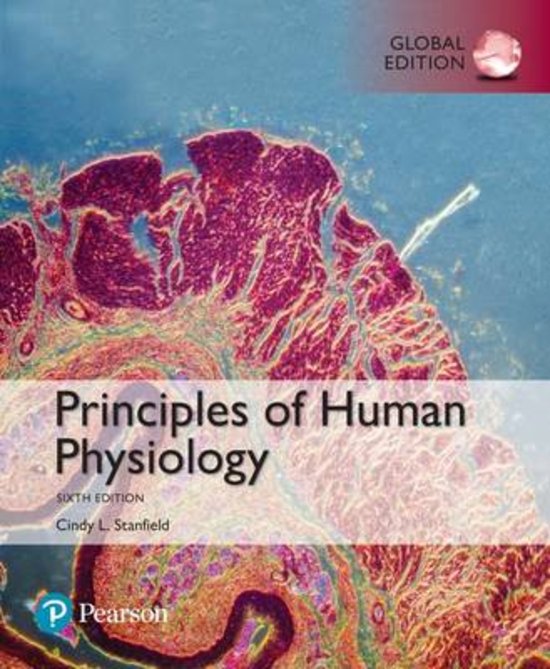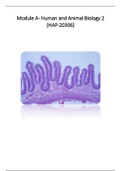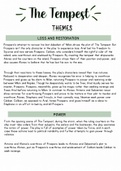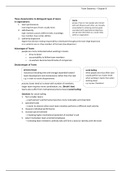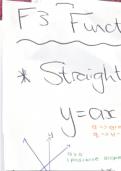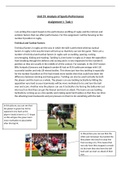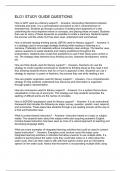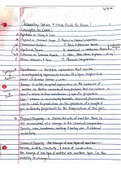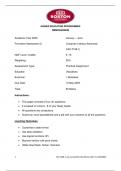(HAP-20306)
,Inhoud
Principles of Human Physiology ............................................................................................................. 4
Chapter 3 ............................................................................................................................................. 4
ATP: The Medium of Energy Exchange............................................................................................ 4
Glucose Oxidation: The Central Reaction of Energy Metabolism ................................................... 4
Stages of Glucose Oxidation: Glycolysis, the Krebs cycle, and Oxidative Phosphorylation ............ 4
Energy Storage and Use: Metabolism of Carbohydrates, Fats, and Proteins ................................. 5
Chapter 13 ........................................................................................................................................... 7
An Overview of the Cardiovascular System .................................................................................... 7
The Path of Blood Flow Through the Heart and Vasculature .......................................................... 7
Anatomy of the Heart...................................................................................................................... 8
Electrical activity of the Heart ......................................................................................................... 9
The Cardiac Cycle........................................................................................................................... 11
Cardiac Output and Its Control...................................................................................................... 12
Chapter 14 ......................................................................................................................................... 15
Physical Laws Governing Blood Flow and Blood Pressure ............................................................ 15
Overview of the Vasculature ......................................................................................................... 16
Arteries .......................................................................................................................................... 16
Arterioles ....................................................................................................................................... 16
Capillaries and Venules ................................................................................................................. 17
Veins .............................................................................................................................................. 19
The Lymphatic system ................................................................................................................... 20
Mean Arterial Pressure and Its Regulation ................................................................................... 20
Chapter 15 ......................................................................................................................................... 21
Overview of the Composition of Blood: The Hematocrit .............................................................. 21
Plasma ........................................................................................................................................... 21
Erythrocytes .................................................................................................................................. 22
Platelets and Hemostasis .............................................................................................................. 22
Chapter 20 ......................................................................................................................................... 23
Overview of Gastrointestinal System Processes ........................................................................... 23
Functional Anatomy of the Gastrointestinal System .................................................................... 23
Digestion and Absorption of Nutrients and Water ....................................................................... 29
General Principles of Gastrointestinal Regulation ........................................................................ 30
Gastrointestinal Secretion and Its Regulation ............................................................................... 30
Gastrointestinal Motility and Its Regulation ................................................................................. 31
Chapter 21 ......................................................................................................................................... 33
2
, An Overview of Whole-Body Metabolism ..................................................................................... 33
Energy Intake, Utilization and Storage .......................................................................................... 34
Energy Balance .............................................................................................................................. 34
Energy Metabolism During the Absorptive and Postabsorptive States ........................................ 35
Regulation of Absorptive and Postabsorptive Metabolism .......................................................... 36
Thermoregulation.......................................................................................................................... 37
Hormonal Regulation of Growth ................................................................................................... 38
Thyroid Hormones ......................................................................................................................... 39
Glucocorticoids (ACTH & CTH)....................................................................................................... 39
Integrated Principles of Zoology .......................................................................................................... 40
Chapter 28 ......................................................................................................................................... 40
Food and Feeding .......................................................................................................................... 40
Chapter 30 ......................................................................................................................................... 42
Temperature Regulation ............................................................................................................... 42
Chapter 31 ......................................................................................................................................... 43
Circulation ..................................................................................................................................... 43
Chapter 32 ......................................................................................................................................... 46
Feeding Mechanisms ..................................................................................................................... 46
Digestion ........................................................................................................................................ 46
Organization and Regional Function of Alimentary Canals ........................................................... 46
3
,Principles of Human Physiology
Chapter 3
ATP: The Medium of Energy Exchange
Cells store energy by synthesizing a compound called adenosine triphosphate (ATP). It is synthesized
from a nucleotide called ADP and a phosphate. The synthesis is a condensation, because water is
generated. The formation of ATP is also a phosphorylation, because a phosphate group is added to
another compound. It occurs during two basic processes: substrate-level phosphorylation (phosphate
group is transferred via an intermediate X) and oxidative phosphorylation (a free inorganic phosphate
group binds to ADP). The last one requires the electron transport system in the mitochondria and
oxygen. Mitochondria can fuse with other mitochondria if one mitochondrion is, for example,
unhealthy, to become healthy again.
When ATP is broken down into ADP and P, the energy required for making it, gets free. This reaction
is called ATP hydrolysis.
Glucose Oxidation: The Central Reaction of Energy Metabolism
All the energy we obtain, is an outcome of the reaction of glucose with oxygen:
C6H12O6 + 6 O2 → 6 CO2 + 6 H20 + energy
This oxidation involves a negative energy
change (ΔE = -686 kcal/mol), thus occurs
spontaneously. The synthesis of ATP,
however, has a positive energy change, so it doesn’t occur spontaneously. When cells use glucose
oxidation to synthesize ATP, energy of the glucose oxidation will be used to drive the ATP synthesis.
This can never be 100% efficient (all energy gained from glucose goes to ATP), otherwise the reactions
won’t work by themselves.
Stages of Glucose Oxidation: Glycolysis, the Krebs cycle, and Oxidative Phosphorylation
The oxidation of glucose occurs in three distinct stages:
- Glycolysis (cytosol): each glucose molecule is broken down in two
pyruvate, and each reaction creates net two molecules ATP (two
ATP are used, four are produced) and two molecules NADH. There
is no oxygen and carbon dioxide involved in this part of the
reaction. The reaction with pyruvate will only continue if there is
oxygen available in the cell, otherwise it will be turned into lactic
acid (not broken down).
- Krebs cycle (mitochondrial matrix): first each pyruvate is
converted into acetyl CoA, which leads to two new NADH
molecules and two CO2 (linking step). Inside the Krebs cycle, the
results are: two CO2, one ATP by phosphorylation, three NADH
and one FADH2 and the final product is oxaloacetate, which reacts
with acetyl CoA to continue the cycle.
- Oxidative phosphorylation (inner mitochondrial membrane):
there are two simultaneous processes, transportation of
hydrogen atoms or electrons in the inner membrane through a
series of compounds (electron transport chain → releases energy)
and the harnessing of this energy to make ATP (chemi-osmotic
4
, coupling). This synthesis is catalysed by ATP synthase. In the end, NADH and FADH2 release
their electrons and protons to the electron transport chain, thereby returning to their oxidized
forms. The released electrons move through the chain by a series of oxidation-reduction
reactions that release energy. Because of this energy, hydrogen ions can cross the inner
membrane and can cause a concentration gradient across the membrane. Some energy is also
stored in this. This energy is released when the ions flow through ATP synthase and are used
for the synthesis of ATP. 2,5 ATP can be made of one NADH and 1,5 ATP can be made of one
FADH2. Released electrons and protons come together again in the mitochondrial matrix to
form water as an end-product.
The rate at which oxygen needs to be supplied to a tissue, depends on its metabolic demand. If it is no
longer possible to keep up with the demand, oxygen levels fall and can even approach zero (anaerobic
conditions). Under these conditions, the ATP-producing steps have the potential to slow down
eventually, which leads to an exhausted supply of ATP. The Krebs cycle and oxidative phosphorylation
become inactive and pyruvate and NADH will accumulate. This causes shutdown of glycolysis.
There is fortunately a solution for this. Most cells contain lactate
dehydrogenase (LDH), which can convert pyruvate into lactate.
When there isn’t any oxygen, NADH can’t unload his electrons to
the electron transport chain. Because of the alternative pathway
via LDH, NADH can unload his electrons and free NAD+ will be
provided for a step in glycolysis. Because this step can run with the
absence of oxygen, the following steps can also run, which provide
ATP.
This does not mean that a body can live without oxygen. With only
glycolysis, just 6% of the possible ATP supply will be produces, way
less than in aerobic conditions. Furthermore, the pathway with LDH
leads to a dead end, where only lactate exists. Lactate then
accumulates and can cause acidification of blood and other
systems. Cells can get rid of lactate: as the cells get oxygen again,
more and more pyruvate will be turned into acetyl CoA and enter the Krebs
cycle. Because of this, the LDH reaction will turn around to produce more
pyruvate and NAD+ will become NADH again. Lactate can also be converted to
glucose in the liver via gluconeogenesis. Glucose will then be transported back
to the bloodstream. This cycle is called the Cori cycle.
The first energy store of your body is ATP that is going around in the body. This,
however, is very limited. Then ATP can be created from phosphate and ADP,
but this is also very limited. The last way is to break down glycogen in muscles
to glucose and to oxidise it to generate ATP (anaerobic).
Energy Storage and Use: Metabolism of Carbohydrates, Fats, and Proteins
Not only glucose can be used as energy source. When glucose supplies are
limited, also fats and proteins can be broken down into smaller molecules that
release energy. When there is plenty of glucose, there can also be a reverse
reaction, so that the body synthesizes fats, proteins and large glucose storage
molecules: glycogen. These reactions only take place in the liver, but
sometimes also in the kidneys.
5
,Glycogen is a branched-chain molecule in animal cells. When there is an
abundant supply of glucose, it is converted into glycogen via glycogenesis.
When the glucose supply is used up quickly, glycogen can be broken down
into glucose via glycogenolysis. Actually, an intermediate of glycolysis will be
produced when glycogen is broken down. In the liver, this will be converted
into glucose, but in other cells, this will be used to produce ATP. This is
because only glucose can be transported through cell membranes.
There always has to be an amount of glucose in the bloodstream, because
nervous system and brain tissue can’t really switch to other energy sources.
If that is not the case, then a body can lose consciousness or can even die. If
a person fasts for a longer time, blood glucose concentrations may fall to
dangerous levels. Fortunately, there is a process called gluconeogenesis. This
happens mainly in the liver, because it has the right enzymes to reverse
glycolysis. In this way, glucose can be formed by glycerol, lactate and
amino acids (except three of them, because they can only be converted
into acetyl CoA).
The adipose tissue is the primary storage depot for fats. Lipids are mostly
stored in the form of triglycerides. Lipolysis is the separation of the
glycerol backbone and the fatty acids. Glycerol can then enter the
glycolysis pathway. Fatty acids can be catabolized into acetyl CoA via beta
oxidation, in the mitochondrial matrix. Because one fatty acid can
produce way more acetyl CoA than one glucose molecule, fats yield more
energy and are therefore called high-calorie foods.
If triglycerides are broken down at a higher rate than demand, ketones
will be generated as a by-product. This is very important, because ketones
can be used by the nervous system as an alternative for glucose.
However, ketones are acids, so they can alter the acid-base balance and
produce a state of ketoacidosis.
Both the pathway for fatty acids as the pathway for glycerol
are reversible, which means that fats can be synthesized from
other compounds in a process called lipogenesis.
For the conversion of proteins, they need to be broken down
in amino acids. This is called proteolysis. The amino acids are
then deaminated (NH2 is removed). This produces ammonia,
which is toxic but can be converted into urea in the liver and
eliminated by the kidney. The remainder of the amino acid is
called a keto acid. This could be pyruvate or acetyl CoA. Also
these reactions are reversible, so proteins can be made of
other compounds. Some amino acids can’t be formed in the
body, those are the essential nutrients.
6
,Chapter 13
An Overview of the Cardiovascular System
The cardiovascular system consists of three components, the heart, blood vessels and blood. The
heart pumps blood, but it also performs sensory and endocrine functions that help regulate
cardiovascular variables such as blood pressure and volume. The heart contains four chambers, atria
and ventricles. It is separated into left and right which are separated by a septum (interatrial and
interventricular). It also has a top and a bottom: the upper pole is the base, the narrow lower pole is
the apex.
The system of blood vessels is called the vasculature. Blood leaves the heart in arteries, which branch
into smaller arterioles which branch into capillaries. Those are the site of exchange between blood
and interstitial fluid. From capillaries, blood enters the larger venules, which enter the veins and they
carry the blood back to the heart. Because the blood moves through the heart and the vasculature, it
is a closed system.
The most cells in blood are erythocytes, red blood cells. These contain hemoglobin, a protein that
carries oxygen. The remainder of the cells in blood are leukocytes, white blood cells. There are also
platelets, cell fragments that play a role in blood clotting. The fluid in which the cells flow is called
plasma and it is made up of water an dissolves proteins, electrolytes, and other solutes.
The Path of Blood Flow Through the Heart and Vasculature
In the figure on the next page you see the general path of blood flow. There are two separate systems,
the pulmonary circuit, all blood vessels within the lungs and those connecting them with the heart,
and the systemic system, the rest of the blood vessels. The right side of the heart supplies blood to
the pulmonary circuit, the left side of the heart supplies blood to the systemic circuit. When blood
leaves the pulmonary capillaries, it is oxygenated blood. Blood leaving the systemic capillaries is called
deoxygenated blood.
7
, The left ventricle pumps oxygenated blood through the aortic valve
into the aorta. This artery branches a lot and eventually into
capillaries of the systemic circuit. Blood will become deoxygenated
and travels back to the heart through the venae cavae, two large
veins that carry blood into the right atrium. The superior vena cava
carries blood from parts above the diaphragm and the inferior vena
cava from parts below the diaphragm. From the right atrium, blood
passes through a valve into the right ventricle. The right ventricle
pumps blood through the pulmonary semilunar valve into the
pulmonary trunk, which almost immediately branches into the
pulmonary arteries. Those are the only arteries in the body that
carry deoxygenated blood! In the lungs, blood becomes oxygenated
and travels back to the heart via pulmonary veins. From the left
atrium, blood passes through the valve into the left ventricle and
the circle starts over again.
The heart obtains its nourishment from the coronary arteries. They
branch off the aorta first, near the base of it.
Within the systemic or the pulmonary circuit, there is a parallel
flow. In the systemic circuit, blood does not flow from one organ to
another. Instead, blood travels through the aorta into arteries that
branch off it. But not only this is parallel, also the blood flow within
organs is parallel, even in the lungs and thus the pulmonary system.
The parallel arrangement of organs in the systemic circuit has two advantages. First, each organ is fed
by a separate artery, so each receives fully oxygenated blood. Second, because of the parallel
pathways, the blood flow can be regulated independently. There are some blood flows that are in
series, like the blood flow between hypothalamus and anterior pituitary, and between gut and liver.
This is called portal circulation.
Anatomy of the Heart
The heart is located in the thoracic cavity just above the diaphragm. This diaphragm separates the
thoracic cavity from the abdominal cavity. The heart is also surrounded by a membranous sac, the
pericardium. The wall of the heart consists mainly of cardiac muscle.
The wall can be divided in three layers. First, an outer layer of connective tissue, the epicardium;
second, a middle layer of cardiac muscle, the myocardium; third, an inner layer of epithelial cells, the
endothelium (continues throughout the entire cardiovascular system). The ventricular muscle layer is
substantially thicker than the atrial muscle layer, because the ventricle has to pump the blood over a
relatively long distance instead of just one chamber further. There is also a difference between the left
and the right side, as the right ventricle has to pump to the lungs and the left ventricle to the whole
body.
The atrial and ventricular muscle are anchored to and separated by a layer of fibrous connective tissue,
the fibrous skeleton. In some places, it also forms the heart valves. The heart has four valves, which
prevent backflow of blood. The atrium and ventricle are on each side separated by atrioventricular
valves (AV valves). AV valves open and close passively in response to the cyclic changes in pressure.
8

